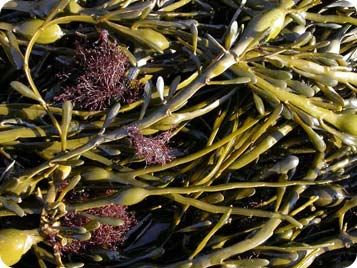Most people probably think their encounters with seaweed are limited - being brushed by its slimy blades while swimming in the ocean, or trying a seaweed salad with sushi. But people come in contact with one component of seaweed in their everyday lives. It’s a compound known as algin.
 Ascophyllum nodosum, a species of brown seaweed used in the production of alginate. Credit: Peter Barfield
Ascophyllum nodosum, a species of brown seaweed used in the production of alginate. Credit: Peter BarfieldAlgin helps form the cell walls of brown seaweeds. It is thought to help protect seaweed blades from desiccation (drying out) when they are exposed to the air at low tide. Algin also plays a part in making the seaweed flexible, and seaweeds that grow in places with stronger current have greater proportions of algin to let them bend with moving water.
Seaweed is commercially harvested and processed to extract the salts of algin, called alginates, which have some unique and valuable properties. One of these properties is the ability to form a gel. Alginate gels are used to make fruit substitutes, instant jelly desserts, and even to bind together the meat used in chicken nuggets!
Alginates also act as thickeners in everything from pie fillings to yogurt, syrup and whipped cream. In the textile
industry, alginates are used to thicken dye pastes to ensure sharp lines on printed fabric. Finally, alginates can act as stabilizers, keeping ice cream smooth and creating a longlasting foam on beer. Producers around the world turn out around 30,000 tons of alginate per year - that means about 750,000 metric tons of wet seaweed are used! And alginates are only one of a myriad of products created from seaweed, putting this versatile marine resource in high demand.


